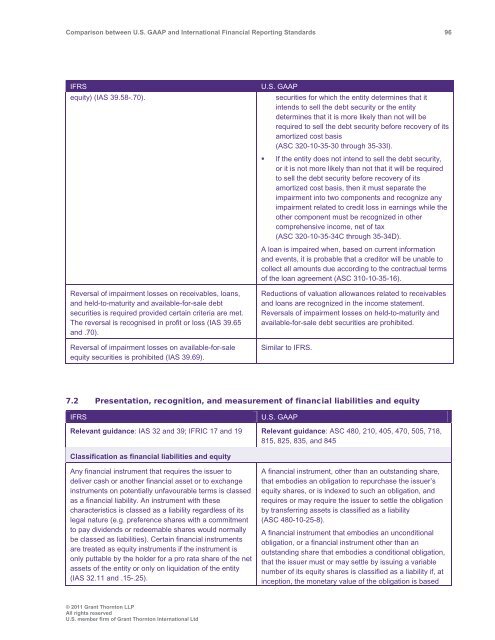Comparison between U.S. GAAP and International ... - Grant Thornton
Comparison between U.S. GAAP and International ... - Grant Thornton
Comparison between U.S. GAAP and International ... - Grant Thornton
Create successful ePaper yourself
Turn your PDF publications into a flip-book with our unique Google optimized e-Paper software.
<strong>Comparison</strong> <strong>between</strong> U.S. <strong>GAAP</strong> <strong>and</strong> <strong>International</strong> Financial Reporting St<strong>and</strong>ards 96<br />
IFRS<br />
equity) (IAS 39.58-.70).<br />
Reversal of impairment losses on receivables, loans,<br />
<strong>and</strong> held-to-maturity <strong>and</strong> available-for-sale debt<br />
securities is required provided certain criteria are met.<br />
The reversal is recognised in profit or loss (IAS 39.65<br />
<strong>and</strong> .70).<br />
Reversal of impairment losses on available-for-sale<br />
equity securities is prohibited (IAS 39.69).<br />
U.S. <strong>GAAP</strong><br />
securities for which the entity determines that it<br />
intends to sell the debt security or the entity<br />
determines that it is more likely than not will be<br />
required to sell the debt security before recovery of its<br />
amortized cost basis<br />
(ASC 320-10-35-30 through 35-33I).<br />
• If the entity does not intend to sell the debt security,<br />
or it is not more likely than not that it will be required<br />
to sell the debt security before recovery of its<br />
amortized cost basis, then it must separate the<br />
impairment into two components <strong>and</strong> recognize any<br />
impairment related to credit loss in earnings while the<br />
other component must be recognized in other<br />
comprehensive income, net of tax<br />
(ASC 320-10-35-34C through 35-34D).<br />
A loan is impaired when, based on current information<br />
<strong>and</strong> events, it is probable that a creditor will be unable to<br />
collect all amounts due according to the contractual terms<br />
of the loan agreement (ASC 310-10-35-16).<br />
Reductions of valuation allowances related to receivables<br />
<strong>and</strong> loans are recognized in the income statement.<br />
Reversals of impairment losses on held-to-maturity <strong>and</strong><br />
available-for-sale debt securities are prohibited.<br />
Similar to IFRS.<br />
7.2 Presentation, recognition, <strong>and</strong> measurement of financial liabilities <strong>and</strong> equity<br />
IFRS<br />
U.S. <strong>GAAP</strong><br />
Relevant guidance: IAS 32 <strong>and</strong> 39; IFRIC 17 <strong>and</strong> 19 Relevant guidance: ASC 480, 210, 405, 470, 505, 718,<br />
815, 825, 835, <strong>and</strong> 845<br />
Classification as financial liabilities <strong>and</strong> equity<br />
Any financial instrument that requires the issuer to<br />
deliver cash or another financial asset or to exchange<br />
instruments on potentially unfavourable terms is classed<br />
as a financial liability. An instrument with these<br />
characteristics is classed as a liability regardless of its<br />
legal nature (e.g. preference shares with a commitment<br />
to pay dividends or redeemable shares would normally<br />
be classed as liabilities). Certain financial instruments<br />
are treated as equity instruments if the instrument is<br />
only puttable by the holder for a pro rata share of the net<br />
assets of the entity or only on liquidation of the entity<br />
(IAS 32.11 <strong>and</strong> .15-.25).<br />
A financial instrument, other than an outst<strong>and</strong>ing share,<br />
that embodies an obligation to repurchase the issuer’s<br />
equity shares, or is indexed to such an obligation, <strong>and</strong><br />
requires or may require the issuer to settle the obligation<br />
by transferring assets is classified as a liability<br />
(ASC 480-10-25-8).<br />
A financial instrument that embodies an unconditional<br />
obligation, or a financial instrument other than an<br />
outst<strong>and</strong>ing share that embodies a conditional obligation,<br />
that the issuer must or may settle by issuing a variable<br />
number of its equity shares is classified as a liability if, at<br />
inception, the monetary value of the obligation is based<br />
© 2011 <strong>Grant</strong> <strong>Thornton</strong> LLP<br />
All rights reserved<br />
U.S. member firm of <strong>Grant</strong> <strong>Thornton</strong> <strong>International</strong> Ltd
















